Operations research is the art of problem-solving and decision-making. In this article, we will learn more about “The Science of Doing Better” and its endless applications.
Introduction
- Did you ever wonder, what is the shortest way to take to get to your shopping destinations and back home, so that you take the least time and be able to finish preparing the birthday party before your friends arrive?
- Are you a project manager, and you want to find the best scheduling for the project tasks, in a way that guarantees to finish the project (if correctly following the schedule and without unexpected hold-ups) within the shortest time frame?
- Do you work in food delivery services, and you ponder about what will be the best route to deliver all the orders and be back, so you can assure the shortest delivery time, satisfy your clients and get good tips, in addition to saving time and being able to do more deliveries?
- Have you a food company, and you are struggling to determine the right amount of raw product to order, in order to maximize the demand satisfaction, alongside minimizing the wasted surplus so that you assure that there is no shortage or excess resulting in more profit and less losses?
- Planning on traveling around the world, and you wonder what would be the best sequence of destinations that help you reduce as much as possible traveling costs, and maybe using the savings to buy some souvenirs?!
- Working in a telecommunications company, and you were handed over the task of finding out the best locations for installing the new antennas so that the coverage of the area is assured with the least number of antennas and therefore reducing the costs?!
If ever you have been in any of these situations or similar problems, you may be interested in knowing about the operations research field. In this article, we will take a journey into the world of operations research, where we strive for the OPTIMUM.
What is Operations Research?
The Operations Research (shortly O.R.) has many names, it is also named Operational Research or Operations Management, usually, the “Operational research” term is used in British English, while the “Operations research” is the name widely used in American English.
Operations research is the discipline of using various and advanced mathematical techniques and methods in order to determine the best solution for a given real-life decision-making problem. It is considered as a branch of the Applied Mathematics field, and sometimes considered the same as decision-making science and management science.
Operations research focuses on practical and real-world applications, applying multiple mathematical methods to obtain optimal (when using exact methods) or near-optimal (when using approximative methods).
Origins and development through time
Some sources may suggest that operations research started way before (it goes back to the 17th and 18th century), but the beginning of the modern operations research took place during World War I when science was used as a way to ameliorate military operations in England, when the British army needed help to reinforce their air and navy forces. In 1917 and as Germany increased the attacks on Britain’s supply lines resulting in destroying an average of one ten ships, causing big losses in lives and supply line disruptions, and to face this situation, Britain’s army gathered scientists to help avoid or reduce the damage caused by the Germans.
After analyzing all the data available to them and modeling the problem, the scientists were able to optimize the size of the convoys, the speed, and the timing for the safest sailing, and only six months later the average losses were reduced to an impressive one in 200 rate, which made Germany’s assaults inefficient.
After World War I, in 1934 and as a measure to reinforce their defense in case of an air attack from Germany, scientists’ simulations showed that in case of war, the German air force can inflict massive damages and takedown vital targets easily, and by 1938 this fatal attack be delivered in only 24 hours window. In order to prevent that, a set of scientists were assigned by the British government to study the practicality of using radio waves against aircraft, the scientists proved that radio waves could detect, track down, and range aircraft, resulting in the invention of the radar.
This invention was not enough, so by merging Scientific Research with Operational Experience (the reason for the name Operational Research) the team was able to determine the best placement and positioning of the radars, resulting in an exceptional air defense system. Therefore, operations research allowed the earliest possible detection and interception of enemy aircraft. Some sources suggest that by the battle of Britain, radar has increased fighter command’s defensive capability by a factor of 10, and operations research doubled this to a factor of 20.
After World War II, operations research was integrated into all kinds of sectors and widely applied to solve problems in infrastructures, health care systems, transport and supply, business, industry, and banking to name a few. The use of operations research quickly increased because of its incredible effectiveness with real-life decision-making problems.
Operations Research Applications
The applications of operations research are endless, helping to solve different problems and backing decisions with science, here is a general list of the main fields using it:
- Project planning: using mathematical methods to determine the optimal sequence order of the different tasks and activities of a given project in order to minimize the duration of completing the project with the least delays possible, while respecting the dependencies between the tasks.
- Facility localization and urban planning: where the aim is to find the optimal placement for the facilities to build, while considering many factors such as reducing transport time, placing hazardous materials and facilities far away from housing or avoid building near competitors’ locations …etc. For example: deciding the most appropriate location for building a fire station in a way to reduce the time needed to reach different parts of the city considering already existing fire stations, population density, city’s road map …etc.
- Supply chain management: operations research is very important in supply chains; it is used to optimize the supply of raw products and materials for different industries and stores like food industries, factories, supermarkets to meet the demand of the clients with fresh products, to avoid shortage and at the same time refrain from overproducing causing waste and price dropping, in other terms maximizing the served demand and minimizing mosses and wastes.
- Transporting: optimizing freight transportation of the products, materials, delivery packages …etc., aiming at reducing as much as possible the delivery or waiting time for the clients. Operations research is used in all the transportation industry: airplanes, boats, Amazon delivery, UPS, FedEx …etc., and by knowing the infrastructure and the shipping power they have, industries like these using operations research techniques can promise you a delivery time and manage to keep it (like delivery in 24H, in 3 days …etc. of course if nothing unexpected goes wrong) and keep the customer happy with their service.
- Scheduling: with the modern world, tasks and events need more and more better scheduling, and here comes the operations research touch, it uses mathematical methods to determine the optimal scheduling for events, project tasks, manufacturing steps …etc. or for transport flow like with airlines, trains, buses …etc. For example, in a given university with hundreds of courses and thousands of groups of students, and since the classes rooms and auditoriums are limited, O.R. helps determining the optimal schedule for every group and every professor. Another example is football leagues, there are many football clubs that need to play many games with consideration for the games in other global leagues and international pause, rest days, transfer period …etc., all this needs to be done in a window of a football season and with O.R. we can have the best schedule for all the games for every football club.
Operations research process
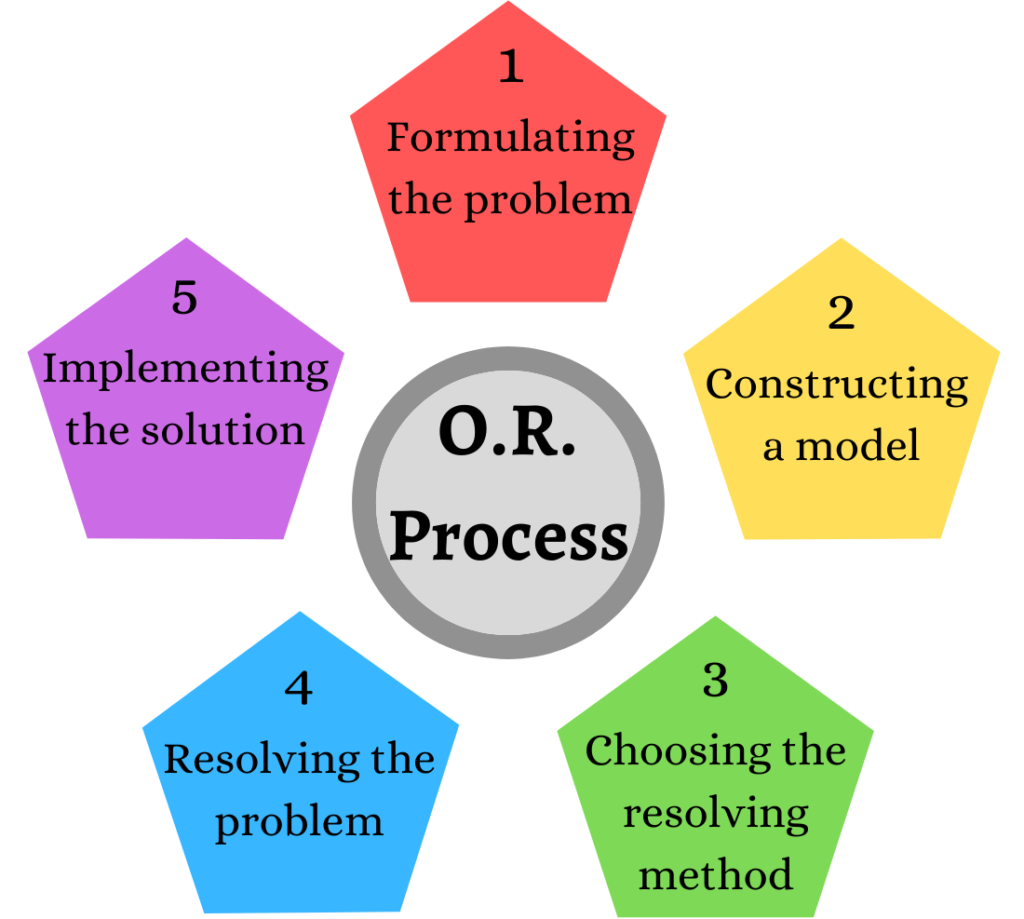
Operations Research Process
Formulating the problem
The first step of the O.R process is to formulate the problem, and it goes without saying that problems in the real world don’t present themselves ready, clearly described, and with well-put information and details in front of the eyes at first sight. The problem statement is often ambiguous and incomplete, usually, the problem contains information that need to be extracted then rewritten in a way that helps get the best use of it, in addition sometimes a problem may embody several other sub-problems to deal with which is may make the problem that seems from far easy to describe and formulate, more complex.
An important goal of this step is to determine the objectives that we want to achieve like minimizing the costs, delivery time or maximizing the profits …etc. Seeing and being able to formulate the problem the right way is a critical step in order to assure that the rest of the work build on this formulation is done on a correct and solid base since it is the first step of the O.R process, also helping in achieving a correct, relevant and useful solution provided for the real problem in hand, not for just a superficial undetailed version of it.
Constructing a model for the problem
The second step of the O.R. process is modeling the problem mathematically, in other terms passing from the word description of the problem in hand to the mathematical version using mathematical modeling methods, the importance of this step is that it prepares the problem for the resolution phase and making it ready to apply solving methods on it. There are many mathematical modeling methods here is a shortlist of the most used and well-known ones:
- Linear Optimization also called Linear Programming
- Non-linear Optimization also called Non-linear Programming
- Graph Theory
- Stochastic modeling or Queuing Theory
- Simulation
It is very important to keep in mind that the solving methods and algorithms depend on the chosen modeling method, i.e. choosing a specific modeling method implies that we use for solving the problem the correspondent solving techniques and changing the model obligate a change in the resolving technique. Every modeling method opens a door for its solving approaches and therefore choosing the best model for a problem is of the essence. A problem can be modeled in several ways but some ways can grant us a better solution with better precision while saving time.
Choosing the resolving technique or method to use
The next step is selecting the method to use, and in this matter, the menu is nothing less than diverse, through time mathematicians and scientists developed a lot of methods, algorithms, and techniques to resolve the different problems. The modeling step will determine in general the set of methods we are able to use but that doesn’t limit the choices at all since every modeling method have plenty of resolution techniques. For example, if we choose to model a given problem using graph theory, now for the resolution we need to choose the methods and algorithms that are developed for graphs, like the Bellman-Ford algorithm or Dijkstra’s algorithm for finding the shortest path in a graph.
Now, and knowing that O.R. solving methods have a great deal of variety, let’s go through the major classifications of these methods:
- Exact methods and approximate methods: the exact methods are able to provide us with the best possible solution and while this is a perfect result, it can’t be the case for every problem since some problems are so big and the complexity of the resolution algorithms is so high that trying an exact method on these problems will take centuries and using the most powerful computers available today. For this reason, scientists introduced approximate approaches where on one hand the time for the solution is reasonable and on the other hand, the solution is often not optimal but it tries to provide a good enough or near-optimal one.
- Deterministic methods and probabilistic methods: deterministic methods are the ones where all the variables are totally known and where it is possible to determine their state at every step of the resolving process with no unpredictable parts or variables. This type of method is used with problems where there isn’t something varying or changing in a way we can’t totally determine or predict. For the opposite case, we use probabilistic methods where there are some variables following some probabilistic behaviors or a probabilistic distribution, this is usually the case for problems dealing with human behavior, for example, the flow of people in the supermarket or in queue lines or in traffic since human behavior can’t be predicted, so using statistics we try to approximately forecast their way of acting to determine what we are looking for (optimize the demand on a product, avoid and reduce the traffic jam hours or minimize the average waiting time for the costumers in a queue for supermarket cashier).
Resolving the problem
In this step, we apply the chosen method to the problem with its data, variables, the relation between them, the restrictions, and the objectives and targets of the optimization process. Depending on the selected approach, the time required for the resolution may vary a lot depending on the level of accuracy wanted for the solution.
For example, after establishing all the possible solutions also called the solution space or the search space which usually contains an infinite number of possible solutions or a finite but immense number of solutions, we have to decide how many iterations we want to perform in the solution space to accept the best solution found by then as the solution to take, since for endless or giant number of possible solutions it’s impossible to try them all and choose the best one.
This step is a very good demonstration of the power of mathematics combined with computing using optimized algorithms and powerful hardware. In addition, very helpful softwares are available to help with the resolution step, from simulation, planning, and scheduling to optimization, forecasting, and computation for discrete combinatorial problems. Some notable software: IBM ILOG CPLEX Optimization Studio, Excel solver, Simulink.
Implementing the solution
The final step of the O.R. process is the implementation, after we got the solution, we proceed to execute the solution in the real world, knowing the specific conditions needed if any, under which the solution can be applied to achieve the wanted result. Also bearing in mind the limitations of the solution if there are any, and keep the implementation and the real execution within the limits, or else the expected results won’t be met and may result in deteriorating the situation instead of improving it.
The step allows us to detect any issues made during the other steps or any unrealistic or impractical assumptions of the variables of the problem or the execution potential in real-life or unexpected complications. In this phase, we validate the results to determine their accuracy and validity or if they need some tuning to overcome some overlooked issues, in addition, reporting any recommendations to be made aiming to ameliorate the results and the implementation process.
Let’s keep in mind that this process divided into 5 steps is just one of many other ways to describe the operations research process, you may find several ones using only 3 steps or some other ones detailing into 7 steps depending on the level of details intended for describing the process.
Careers with operations research
After introducing operations research, its development, applications, and its process, we will discover in this section the possible opportunities and careers that operations research opens, the demand for O.R. in the market, the salaries, and some forecasts into the future. For this, we will take the USA as a study case and the statistics and results we are about to study here are from the US Bureau of Labor Statistics Occupational Employment Statistics (2019 Data).
The job of Operations research analyst can also have many other similar, usually overlaying or intersecting, occupations like Logisticians, Management Analysts, Market Research Analysts …etc.
In the following statistics, we will take operations research analysts as the study case.
Average base salary of operations research analysts
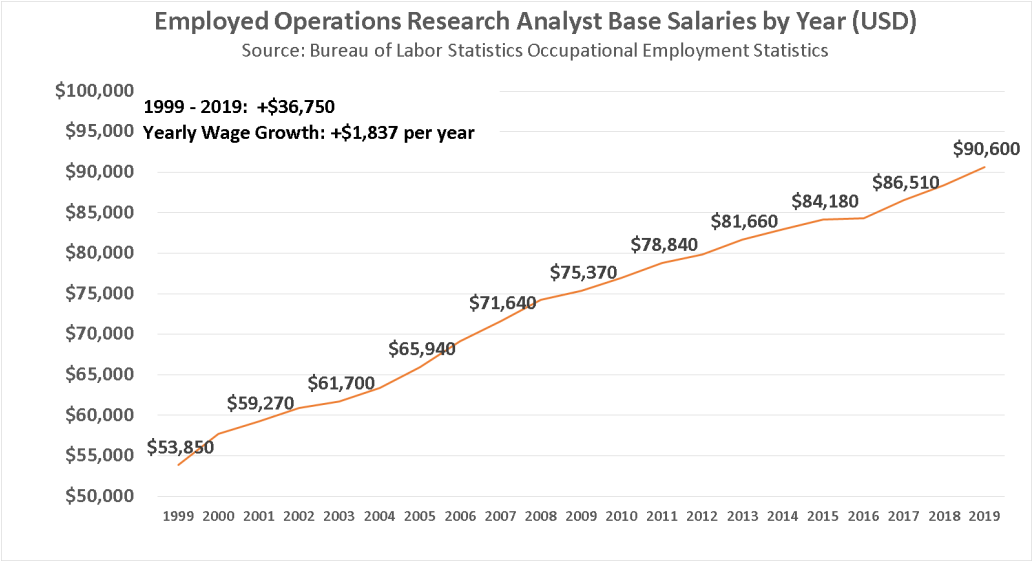
Employed Operations Research Analyst Base Salaries by Year
The statistics show the growth of the base salary during 20 years (from 1999 to 2019), we can see a big rising in salaries from $53,850 in 1999 to $90,600 in 2019 which means that the wages grew by $36,750 in 20 years or by an average of $1,837 per year.
Note that the salaries do not include bonuses, signing bonuses, benefits, overtime, tips, or commissions.
Operations research analyst wage forecast
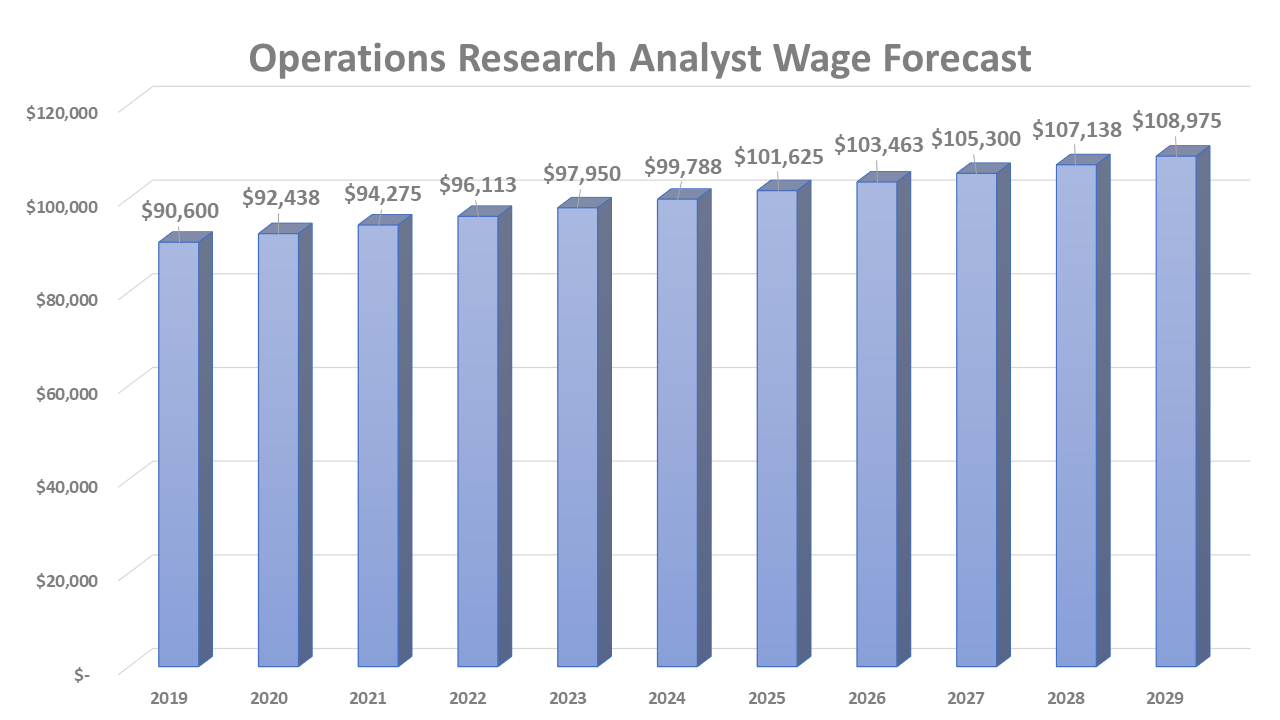
Operations Research Analyst Wage Forecast
This chart represents the average base salary estimation for a window of 10 years (2019-2029), it shows that by 2021 the average salary is estimated to be $94,275 and by 2029 it would rise to $108,975.
Operations research analyst base salary by state
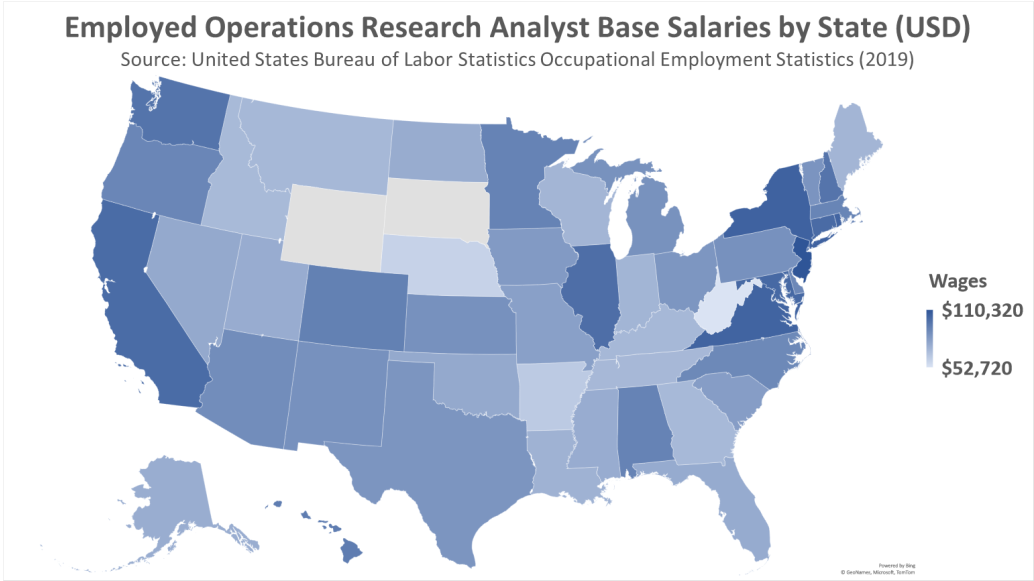
Employed Operations Research Analyst Base Salaries by State
The map shows a remarkable difference in base salaries between different states, where the darker blue the state is on the map the higher is the base revenue.
The top 5 highest paying states are:
- New Jersey: $110,320
- DC: $109,740
- New York: $104,890
- Virginia: $104,090
- Rhode Island: $103,710
The top 5 lowest paying states are:
- West Virginia: $52,720
- Nebraska: $59,470
- Arkansas: $62,900
- Idaho: $69,450
- Georgia: $69,840
We can see that there is a $57,600 difference between the highest and the lowest paying state.
Operations research analysts work sectors
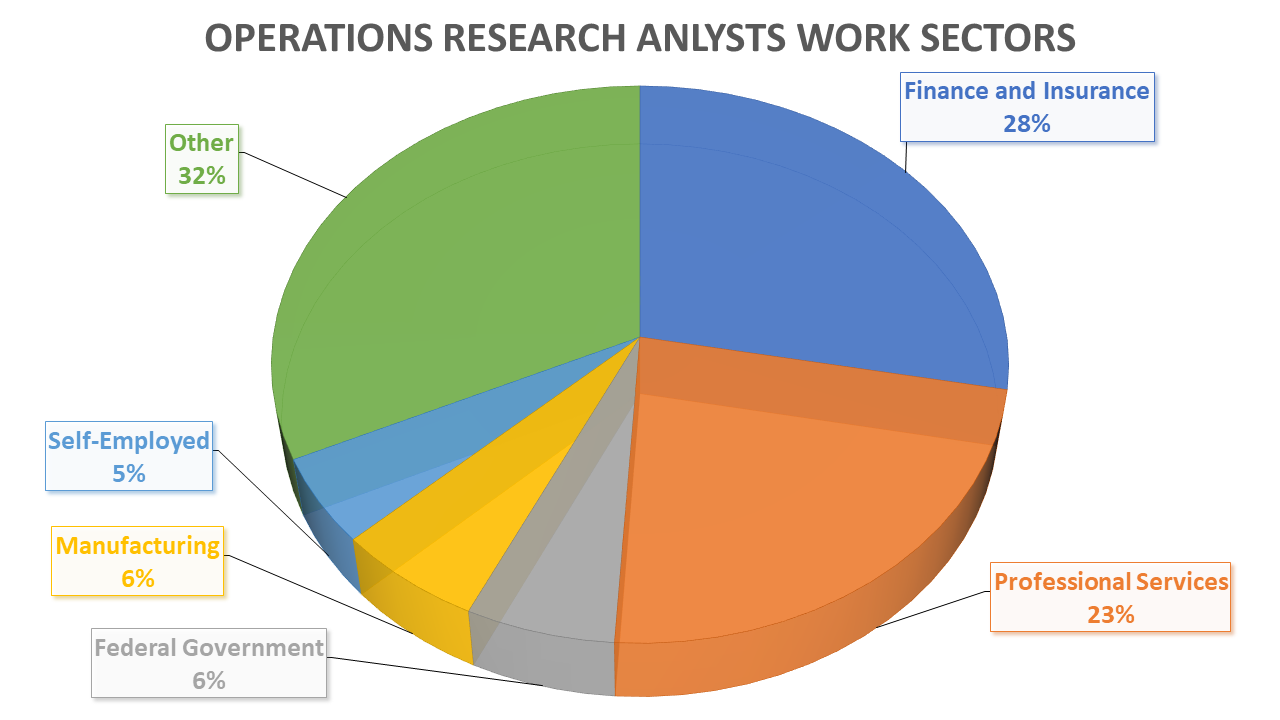
Operations Research Analyst Work Sectors
We notice that the Finance & Insurance sector and the Professional Services sector are incorporating the most operations research in their environments, followed by the Federal Government and Manufacturing sectors. We also see a big portion of 32% for the other sectors since operations research has multiple applications in almost every field.
Also, the statistics give us a view on how the 2019 pay breaks down by work environment:
- Federal Government: $113,940
- Manufacturing: $92,320
- Professional Services: $86,170
- Finance and Insurance: $85,320
We can see that the Federal Government sector is paying higher with a remarkable margin from the other work environments.
Operations research average base salary compared to closer or related occupations
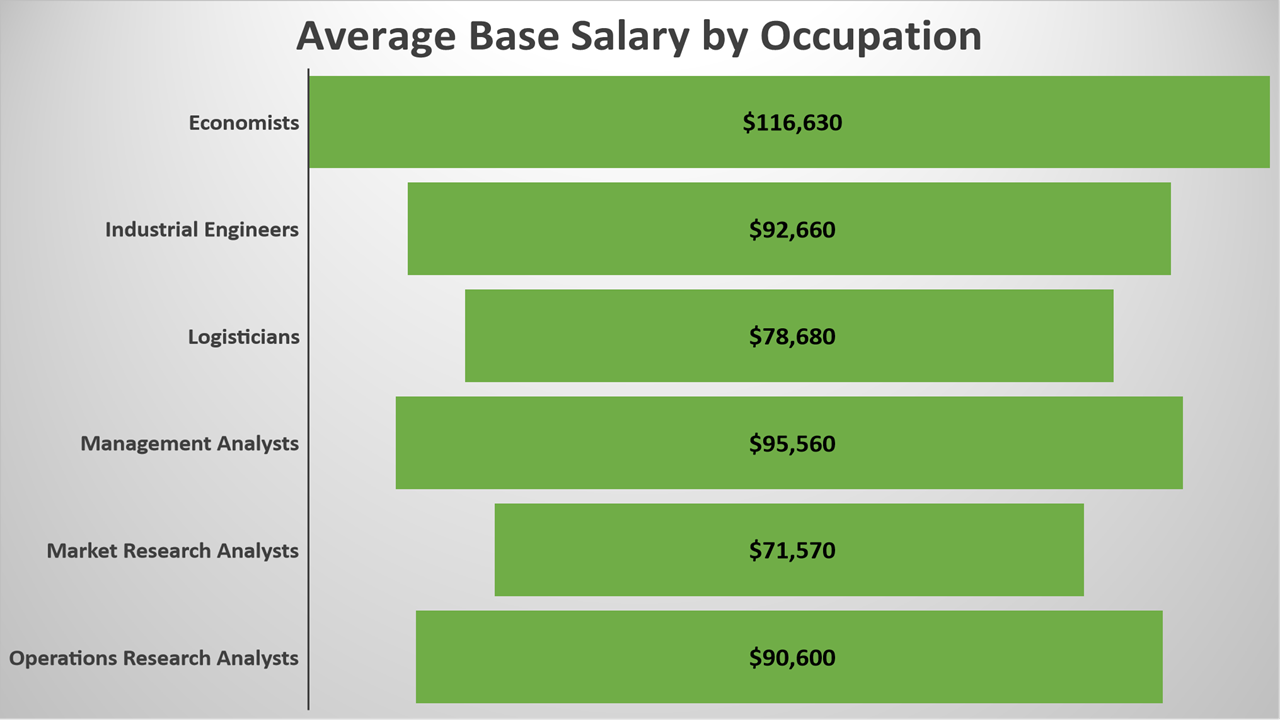
Average Base Salaries by Occupation
Reading the chart, we conclude that taking the average base pay as a reference, operations research analysts outearn logisticians and market research analysts with a remarkable margin. Also, operations research analysts are outearned with a small difference by industrial engineers and management analysts and outearned with a big difference of $26,030 by economists.
Employment rate forecast
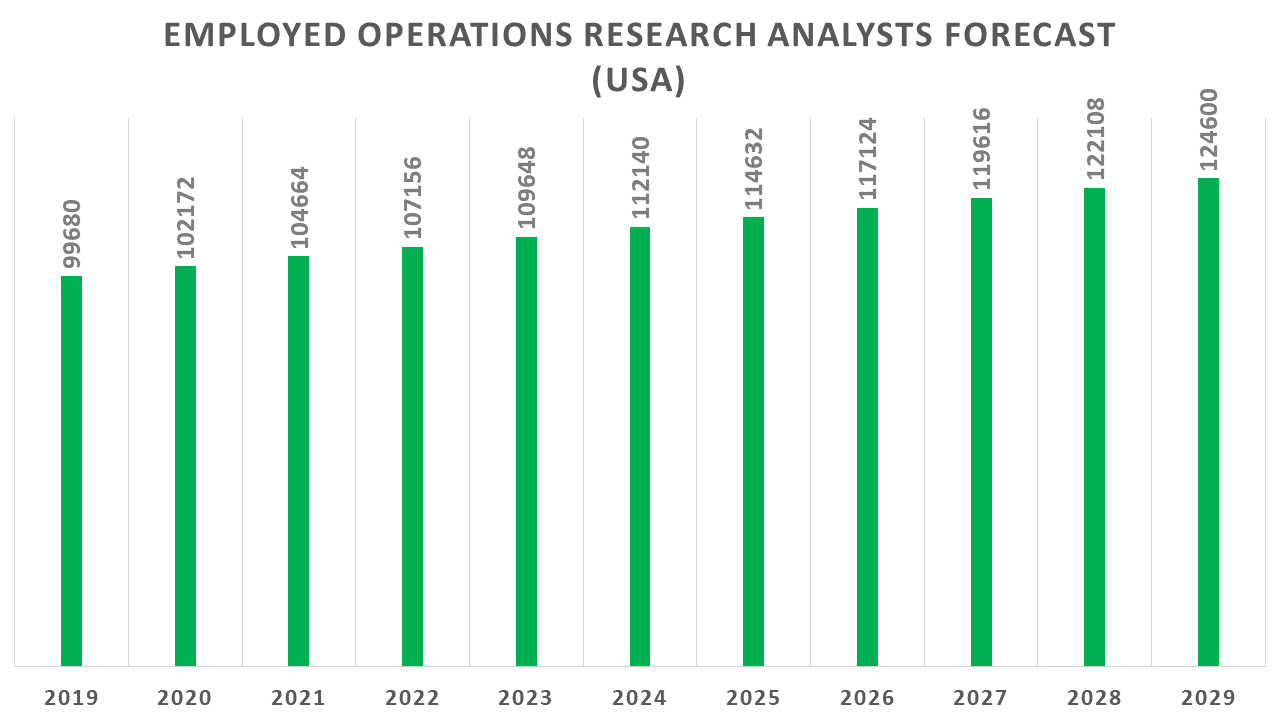
Employed Operations Research Analysts Forecast
As we can see in the chart, operations research analysts are more and more in demand, and we expect that to be the case for the long future since decision-making and optimization are not a luxury for any field and for its uses in all the sectors including the super growing ones like Artificial Intelligence and Machine Learning. At the end of the decade, we predict to reach 124600 new employed operations research analysts.
Academic education statistics

Academic Education of Operations Research Analysts
The chart shows that even operations research analysts that only have a bachelor’s degree have a decent portion with 30% of the total occupations, but we also see that operations research analysts with master’s degree have better chances and representing 70% of the total occupations, meaning that having a bachelor’s degree good and opens several opportunities and you can choose to widen your knowledge with a master degree and enter the job market with more chances at hand.
Useful sources
Are you interested in knowing more about operations research and its endless applications? Here are some links to some resources that you may want to check:
- The Operations Research Society: https://www.theorsociety.com
- The International Federation of Operational research societies: https://www.ifors.org
- The Institute for Operations Research and the Management Sciences: https://www.informs.org
Conclusion
Operations research is an important discipline and science to incorporate into every business and so many fields, and since decision-making is necessary, crucial, and a key step of today’s world, then comes into view the operations research earning the title of the art of problem-solving and decision making, letting the world reap the benefits by integrating the science of doing better in every aspect possible.
